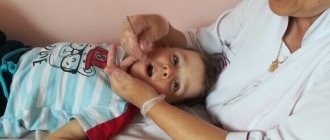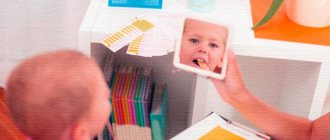The approach to correcting speech disorders in cerebral palsy requires complex work: a speech therapist-defectologist; neurologist; psychologist. Classes should be started according to the principle “the sooner the better,” since the child’s nervous system is more susceptible than that of a teenager. Correction and development of speech in a child with cerebral palsy occurs fruitfully at an earlier age.
The method of correcting speech disorders in cerebral palsy is selected individually and depends on the degree and severity of the disorders, level of intelligence, and the area in which the central nervous system is affected. Speech correction classes are conducted individually so that the child can more easily perceive information and follow the speech therapist’s instructions more productively.
In children with cerebral palsy, speech impairment can occur due to 2 reasons:
- This is a lesion of the brain structures responsible for speech and the proper functioning of the speech apparatus.
- Disturbance in the maturation of brain regions, which normally occurs as the child matures and acquires speech skills.
Speech disorders are associated with motor pathological reflexes and articulation disorders. Even though their intelligence is preserved, it is difficult for such children to speak; the speech development of children with cerebral palsy suffers greatly.
WORK OF A Speech Pathologist IN SPEECH CORRECTION
The speech therapist works in the following areas:
- Speech therapy gymnastics aimed at normalizing the articulatory apparatus;
- Logomassage, which helps to activate speech centers;
- Probe massage;
- Creating a desire in the patient to talk;
- Expansion of vocabulary (active and passive);
- Mastering grammatical criteria;
- Correction of sound pronunciation;
- Activation of the child’s attention and perception.
- Decreased salivation and development of chewing and swallowing skills.
Consequences of cerebral palsy
Characteristic features of cerebral palsy are disturbances in motor activity, the muscular sphere is especially affected - there is a lack of coordination of movements. Depending on the extent and location of areas of brain damage, one or more forms of muscle pathology may occur^
- muscle tension or spasticity;
- involuntary movements;
- disturbance of gait and degree of mobility.
The following pathological phenomena may also occur:
- abnormality of sensation and perception;
- decreased vision, hearing and speech impairment;
- epilepsy;
- impaired mental function.
Other problems include difficulty eating, decreased urinary and bowel control, breathing problems due to poor posture, bedsores and learning difficulties.
WORK ON SPEECH DEVELOPMENT
When working on speech production, proper breathing is important. It is improved with simple exercises (inflating balloons, using whistles, blowing out a candle).
Good results in speech correction are shown by reading fairy tales and poems aloud. Sound pronunciation by imitation of different sounds, isolated repetition of each of them.
Speech therapy assistance should be gradual and daily, only then will it give visible results.
It is very important that parents participate in this process, who can consolidate the specialist’s results and increase them, as well as adapt their children to the environment as much as possible.
Story
In 1860 English surgeon William Little first published the results of his observations of children who, after suffering a birth injury, developed paralysis of the limbs. The children's condition did not improve or worsen as they grew: problems with the grasping reflex, crawling and walking remained. Signs of such lesions in children have long been called “Little’s disease”; they are now known as “spastic diplegia”. Little suggested that these lesions were caused by oxygen deprivation (hypoxia) during childbirth. However, in 1897, the famous psychiatrist Sigmund Freud, noting that children with cerebral palsy often suffered from mental retardation, visual perception disorders and epileptic-type seizures, suggested that the cause of such deeper brain lesions was rooted in the pathology of the infant’s brain development at an earlier age. period of life - during the period of fetal development in the womb.
Despite this assumption by Freud, until the 1960s of this century, it was widely believed among doctors and scientists that the main cause of cerebral palsy was complications during childbirth. But in 1980, after analyzing data from national studies of more than 35,000 cases of newborns with signs of cerebral palsy, scientists were amazed that complications due to birth trauma were less than 10%. In most cases, the causes of cerebral palsy have not been identified. And from then on, extensive research began on the perinatal period of life: from the 28th week of intrauterine life of the fetus to the 7th day of the newborn’s life.
SPEECH DEVELOPMENT OF CHILDREN
The development and future of a child with cerebral palsy largely depends not only on his potential capabilities, but especially on the correct selection of correction techniques.
Features of speech disorders in children with cerebral palsy depend on the location of the severity of brain damage. The more pronounced the defect in the nervous system or areas of the brain, the stronger the functional impairment.
In our center, complex therapy is used in the treatment of cerebral palsy. Along with physical recovery, we pay great attention to the speech development of our patients. And the sooner they begin to engage in the child’s recovery, the sooner and faster he will see good results. The brain of a small child develops very actively, and is able to “delegate” some of the work from the affected departments to other departments. This means that the child’s condition can be compensated for.
At the first meeting with the child, specialists determine the child’s speech therapy level and choose a plan of action aimed at speech development. Work with a child is done individually, because Children have completely different levels of speech. A session with a speech therapist is aimed at improving the functioning of the articulatory apparatus. To do this, the child is engaged in speech therapy gymnastics, a special speech therapy massage is performed, the voice is stimulated, the respiratory system is developed with the help of auxiliary aids, and the child is encouraged to speak. Then comes work on building up the passive, followed by the active vocabulary and the formation of coherent speech. Which subsequently leads to the establishment of communication between patients and others.
Features of the work of a defectologist
Speech therapy work for cerebral palsy is carried out using a specially developed methodology, taking into account the individual characteristics of the child’s psyche. A defectologist must use in his work the results of psychologist research indicating the degree of impairment of intellectual function. Classes are structured so that it is convenient for the child to perceive information.
It should be remembered that speech disorders in sick children arise as a result of damage to certain areas of the brain responsible for speech functions. While the child is still small, correction of the consequences of this lesion occurs faster. As the patient gets older, the maturation of the “speech” areas of the brain is disrupted.
In parallel, disorders associated with pathological reflexes leading to articulation dysfunction and associated dyslexia should be corrected. After all, the more pronounced the defect in the functioning of the nervous system is, the stronger the functional impairment.
OUR PROGRAM
At the Medical School, a whole range of activities have been developed for the correction and development of speech, complementing each other. The complex includes: the work of professional speech therapists and speech pathologists; Tomatis technique, which is aimed at speech correction using special programs and allows you to achieve good results twice as fast; BAC (bioacoustic correction) procedure, which improves mental activity, perception, attention. Acupuncture aimed at reducing salivation and stimulating points responsible for speech. Also in our center there is a procedure performed by a Chinese specialist - facial qigong, which uses various techniques aimed at correcting speech disorders in cerebral palsy, such as swallowing, chewing, relaxing spasmodic facial muscles, and the emergence of new sounds. Our statistics confirm good results in 95% of patients.
The medical clinic accepts patients from all regions of the country: Moscow, St. Petersburg, Yekaterinburg, Chelyabinsk, Novosibirsk, Ufa, Kazan and others.
Types of Cerebral Palsy
There are three main types of cerebral palsy:
- Spastic - the patient has great stiffness and difficulty moving: 70-80% of patients;
- Athetoid (athetoid), or dyskinetic - the presence of involuntary, uncontrolled movements (hyperkinesis): 10-20% of patients;
- Ataxic (ataxic) - imbalance, the presence of deep-seated mental deviations: 5-10% of patients.
A mixed type (from the above) is possible. There are other types of cerebral palsy, although they are rare.
Comments
This study is confirmed by similar data in the USA, Germany, and Russia. It is clear that special attention needs to be paid to when brain damage occurs, what are the risk factors that put the infant's health at risk, and what are the most common consequences of cerebral palsy. As the likelihood of cerebral disorders increases due to the increasing number of surviving premature infants, studying the causes of low birth weight and premature birth is becoming a priority in research.
How many people have cerebral palsy?
Some statistics:
Cerebral palsy is the most common cause of childhood disability, among which the first place is diseases of the nervous system. Cerebral palsy is the second most common neurological disorder in childhood; The first is mental retardation in children. In third place are congenital anomalies.
Latest publications in an international scientific research journal:
Evolutionary medicine and child neurology and the Research Foundation of Cerebral Palsy Associations (UCPA, USA) provide insight into the statistics of the birth of children suffering from cerebral palsy.
Among children with normal birth weight who become disabled due to cerebral palsy:
- approximately 70% became disabled due to factors that occurred before birth (prenatal period),
- about 20% - due to factors that appeared either during childbirth (perinatal period) or immediately after birth (the first four weeks of life),
- 10% - due to factors that appeared during the first two years of life (postnatal period)
Among low birth weight (or premature) children in whom cerebral palsy is the cause of disability: the incidence is approximately 0.7 per 1000 live births;
There is still no certainty as to when the brain damage occurred:
- did cerebral lesions occur during embryonic development?
- or due to the use of neonatological techniques for preserving the baby?
- Have cerebral lesions occurred during or after birth in infants with “vulnerable” (“easily injured”) brains?
According to the Research Foundation of Cerebral Palsy Associations (UCPA), there are approximately 550,000 people with the disease in the United States and 9,750 children and newborns are diagnosed with the disease each year. Of these, 1.2-1.5 thousand are preschool children. The number of births of patients with signs of cerebral palsy in the United States has increased by 25% over ten years: from 1.5 to 1.8. per 1000 babies born alive in 1990. up to 2.0 - 2.5 infants with this pathology in 2000. Currently in the United States there are from 550 to 760 thousand disabled people with cerebral palsy, which is 2.8 people per 1000 population.
In Moscow, according to Professor E.G. Sologubov, there is an increase in the incidence of cerebral palsy: over 20 years (from 1967 to 1987), the number of births per 1000 children increased from 1.71 to 1.88 in 1992 in Russia there were 62 thousand, and in the territory of the former USSR - 122 thousand patients with Cerebral palsy (patients under 15 years of age were taken into account). the frequency of occurrence in 2001 was (according to various sources) 5.0-6.0 per 1000 newborns
It should be noted that statistical data on the number of patients with cerebral palsy in the USSR were not available, and even the few statistical data tended to be underestimated.
In Moscow there are approximately 10 thousand disabled people with consequences of cerebral palsy, half of them are children. In the Moscow region - about 5 thousand people. Based on the frequency of births of children with signs of cerebral palsy (5.0-6.0 per 1000), it can be assumed that there are at least 1.5 million such disabled people in Russia. There are no exact data on the number of disabled people with consequences of cerebral palsy in Russia.
In terms of severity, one of the most common lesions now associated with new views of cerebral palsy is spasticity of one or more limbs.
It turns out that muscle spasticity of the limbs at the birth of a normal-weight baby is caused by lesions that dominate the prenatal period; and at the birth of premature babies and children with low weight, spasticity of the limbs is caused by lesions that dominate in the perinatal (from the 28th week of intrauterine life of the fetus to the 7th day of the newborn’s life) and neonatal periods of the newborn.
Can cerebral palsy be prevented?
Yes. Currently, the chances that make it possible to prevent the occurrence of cerebral palsy have increased: testing and monitoring the health of the mother during pregnancy. First of all, the definition of the RH factor. If Rh is negative, immunization must be carried out within 72 hours after birth (or at the end of pregnancy), which will prevent the adverse consequences of blood incompatibility in a subsequent pregnancy. If the woman has not been immunized, the consequences of blood incompatibility in the newborn can be prevented by an exchange transfusion of blood in the child.
If a newborn is diagnosed with jaundice, he is subjected to light therapy in the infant feeding department. There are other methods to prevent premature birth. These measures reduce the likelihood of viral diseases and other viral infections in pregnant women. The birth of sick children is greatly influenced by increased radiation and the use of drugs and other medications by pregnant women.
To prevent the possible birth of a sick child, it is necessary to monitor patients with diabetes mellitus, anemia (anemia), and control over the rational nutrition of pregnant women. Great importance should be given to creating favorable conditions for the birth of a healthy child. The assistance of highly qualified specialists in the prenatal period is necessary, and newborns should also be protected from accidents and injuries.









